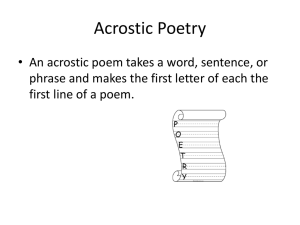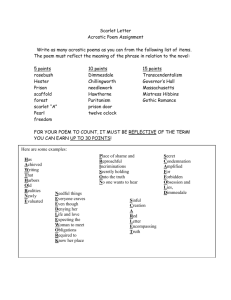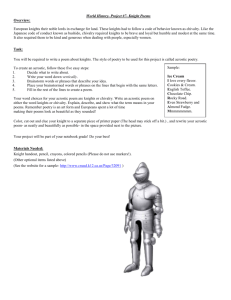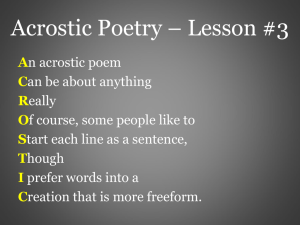Acrostic Poem
advertisement
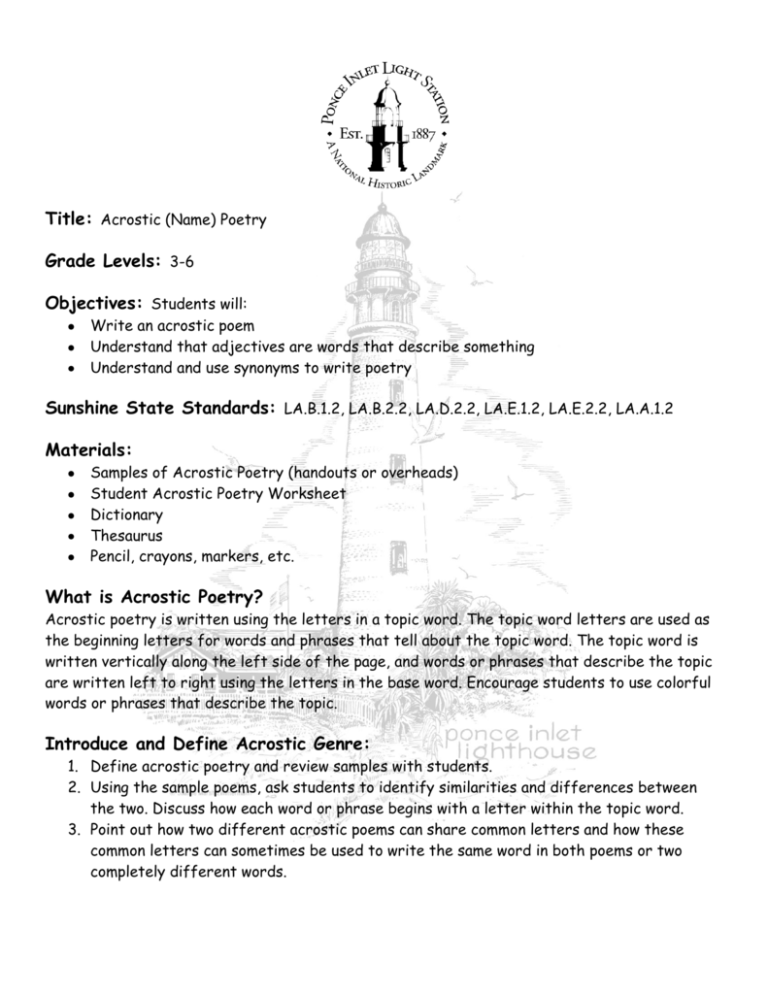
Title: Acrostic (Name) Poetry Grade Levels: 3-6 Objectives: Students will: Write an acrostic poem Understand that adjectives are words that describe something Understand and use synonyms to write poetry Sunshine State Standards: LA.B.1.2, LA.B.2.2, LA.D.2.2, LA.E.1.2, LA.E.2.2, LA.A.1.2 Materials: Samples of Acrostic Poetry (handouts or overheads) Student Acrostic Poetry Worksheet Dictionary Thesaurus Pencil, crayons, markers, etc. What is Acrostic Poetry? Acrostic poetry is written using the letters in a topic word. The topic word letters are used as the beginning letters for words and phrases that tell about the topic word. The topic word is written vertically along the left side of the page, and words or phrases that describe the topic are written left to right using the letters in the base word. Encourage students to use colorful words or phrases that describe the topic. Introduce and Define Acrostic Genre: 1. Define acrostic poetry and review samples with students. 2. Using the sample poems, ask students to identify similarities and differences between the two. Discuss how each word or phrase begins with a letter within the topic word. 3. Point out how two different acrostic poems can share common letters and how these common letters can sometimes be used to write the same word in both poems or two completely different words. 4. Ask students to volunteer other words that begin with the same letters used in either poem. Point out and discuss how the chosen words reflect on the main subject of the poem. 5. Encourage students to stretch their vocabulary and use a dictionary or thesaurus to find more colorful “r” words, such as roaring, rolling, rocking, etc. Remind students that good poets are always searching for the word that most accurately conveys the meaning they want to express. Dictionaries and thesauruses are good tools to use to find those words. Word Work: Adjectives and Synonyms: 1. Review the meaning and function of the following terms: Adjective: A word or phrase that is used to describe a noun. Synonym: A word having the same or almost the same meaning as another word. 2. Discuss how understanding adjectives and synonyms can help a poet find words that fit the criteria of an acrostic: the words must describe the topic and begin with one of the letters of the topic. For example, if the poet wants to describe sun by using the adjective light but the letter he/she is working with is r, then the poet must search for a synonym for the adjective light that begins with the letter r (ray or radiant). 3. Use this opportunity to introduce and model using a thesaurus. Explain to students how to locate an adjective in a thesaurus and then list the synonyms for that adjective. Encourage them to practice the activity with other words before they use a thesaurus for their acrostics. Model Writing an Acrostic Poem: 1. The first step in writing an acrostic poem is to choose a good topic. Acrostic poems may be written about any topic. Choose a topic that can be described using a variety of words or phrases. Write the word vertically on the board or on an overhead. 2. Have students brainstorm possible words that can be used to describe the topic of the poem using the letters found in each topic word. Record students' suggestions on the board or overhead projector next to the corresponding letter. 3. Allow students to pick the best word from the list for each letter. Voting by show of hands is a fast and effective way to identify the most popular word or phrase. Ask for a volunteer to record student responses using tally marks. 4. Write the subject word vertically on the board or on another overhead slide and model how to create an acrostic poem using the chosen word or phrase for each letter in question. Independent Practice Activity: 1. Hand out Lighthouse Acrostic Poem worksheet and inform students that they will be writing their own acrostic poem using the letters in the word LIGHTHOUSE. 2. Remind students that each line in an acrostic poem typically begins with a capital letter and that the letters used in the base word, or topic, are usually stressed with bold print or with an ornate design. 3. As the students write, encourage them to brainstorm to find words and phrases that communicate and fit the structure of their acrostic poem by listing possible words or phrases for each letter on a separate piece of paper that fit the structure of their acrostic poem. 4. Have students revise their work in order to improve understanding and flow by adding, deleting, consolidating, and rearranging words as necessary. 5. Encourage students to use a dictionary or thesaurus to find synonyms or adjectives that may be used to make their poems more interesting. Extend the Activity Celebrate the writing process by having students read their poetry aloud with fluency, rhythm, and expression. Encourage students to write acrostic poetry on a topic that is the opposite of one they have already written. For example, if they wrote an acrostic on peace, have them write one on war. Publish the opposing poems on facing pages in a class book. Have students share their writing with as many different audiences as possible. Poetry may be published through classroom or school-wide displays, a poetry book, a school newsletter or website, an online poetry contest, or any other creative form of communication. Extend acrostic poetry across the curriculum using a variety of topics. Use the alphabet in alphabetical order to write an acrostic on a given topic, such as friendship, animals, or landmarks. urious like George appy as can be wesome baseball player! igzagging on my skateboard eeps on jumping day after day ustralia's most interesting mammal ever leaves its babies alone reatest marsupial of all time! lways on the lookout for hungry dingoes eady to spring away when danger is near ften carries joey around in its pouch utback jumper from Down Under! urious ffectionate abby Student Name: _________________
